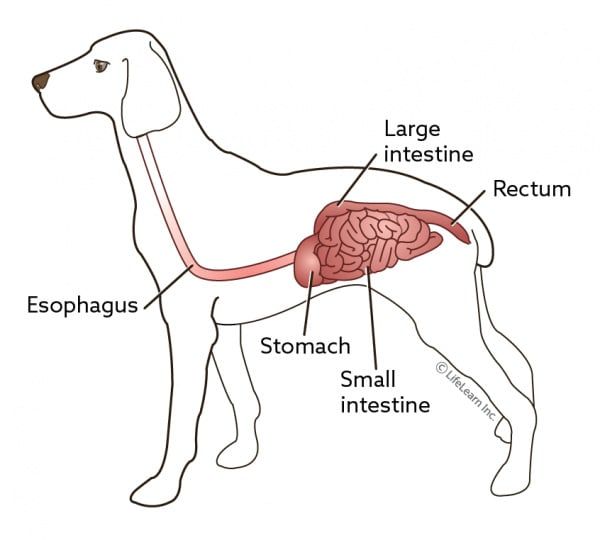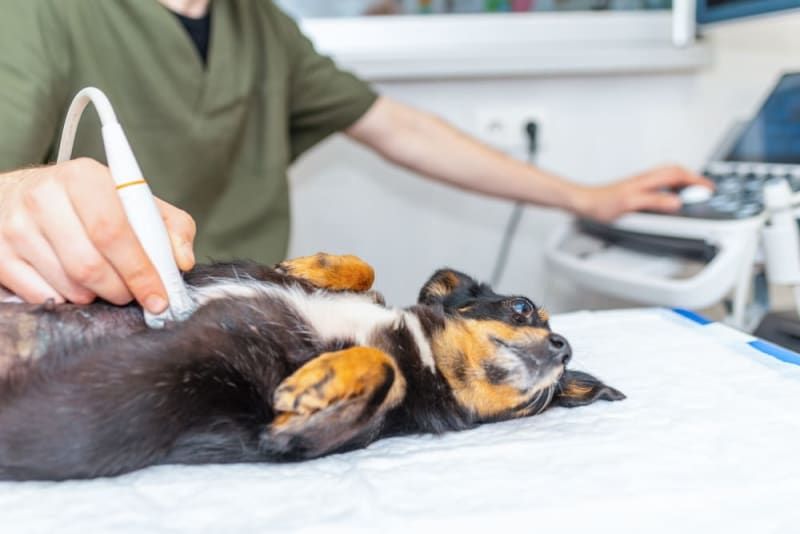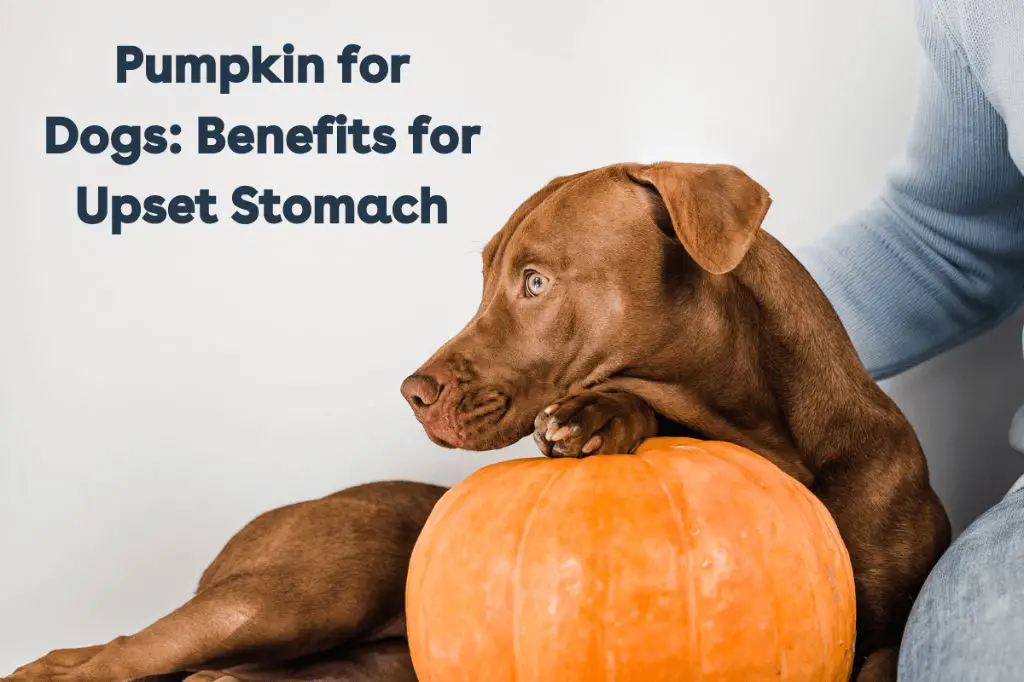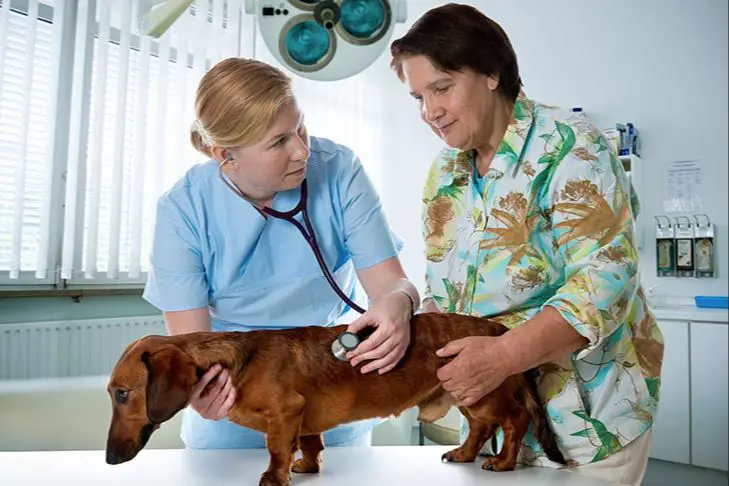What is a gastrointestinal obstruction in dogs?
A gastrointestinal (GI) obstruction refers to a blockage that forms in a dog’s digestive tract, preventing food and fluid from passing normally through the system. Obstructions can occur in the esophagus, stomach, small intestine, or large intestine.
Common causes of GI obstructions in dogs include:
- Swallowing foreign objects such as rocks, toys, clothing, or sticks
- Ingesting something too big to pass through the intestines like large bones
- Twisting of the intestines
- Tumors or abnormal tissue growth narrowing the digestive tract
- Scar tissue from previous surgeries or infections
Symptoms of a GI obstruction in dogs may include:
- Repeated vomiting
- Diarrhea or constipation
- Loss of appetite
- Weight loss
- Abdominal pain
- Bloating of the abdomen
- Straining to defecate with little production
When to seek veterinary care

If your dog is showing any signs of a possible gastrointestinal obstruction, it’s crucial to seek veterinary care right away. Some warning signs that indicate an obstruction may include:
- Repeated vomiting
- Loss of appetite
- Lethargy
- Abdominal pain or distension
- Gagging
- Drooling
- Difficulty defecating
- Bloated or hard abdomen
- Straining but producing little stool
- Dehydration
Gastrointestinal obstructions can quickly become life-threatening if left untreated. Potential risks and complications of delaying veterinary care include:
- Rupture or tearing of the gastrointestinal tract
- Perforation of intestines or stomach
- Sepsis due to bacterial buildup
- Metabolic disturbances
- Malnutrition and weight loss
- Dehydration leading to kidney failure
- Death
Don’t wait to see if signs resolve on their own. Get veterinary assessment right away if an obstruction is suspected. Quick action can help minimize risks and may be lifesaving.

Diagnosing obstructions
If your dog is showing signs of a possible gastrointestinal obstruction, the vet will first perform a physical exam. They will check for a distended or painful abdomen, listen for abnormal intestinal sounds, and palpate the abdomen to feel for any obstructions or foreign objects. The physical exam provides important initial clues, but imaging tests are needed to confirm an obstruction.
Imaging tests like X-rays or ultrasound allow the vet to visualize the intestines and identify any blockages. X-rays can detect many obstructions, especially bones, rocks or other dense materials. Ultrasound provides a more detailed look at the intestinal tract and may find obstructions in the small intestine that don’t show up on X-rays. Ultrasound is also useful for identifying masses, foreign bodies, or volvulus (twisted intestines). The imaging results will help determine the location and possible cause of the obstruction.
Treatment Options
If your dog is diagnosed with a gastrointestinal obstruction, the vet will likely recommend one or more of the following treatment options:
IV Fluids
One of the first steps in treating an obstruction is to stabilize the dog by providing intravenous (IV) fluid therapy. This helps correct dehydration and electrolyte imbalances caused by vomiting and inability to eat normally.
Surgery
Many types of obstructions require surgery for removal. This may involve making an incision into the stomach or intestines to manually remove the blocked object or material. Surgery carries risks but is often necessary to resolve an obstruction.
Medications
Medications may be prescribed to control nausea and vomiting, provide pain relief, regulate gut motility, or soften obstructions to allow passage. Examples include antiemetics, analgesics, prokinetics, and laxatives. Your vet will determine if medication is appropriate for your dog’s situation.
Can pumpkin help pass obstructions?

Pumpkin is sometimes recommended as a natural laxative to help dogs pass mild gastrointestinal obstructions. The high fiber content in pumpkin can help stimulate bowel movements. Some vets may suggest 1-4 tablespoons of canned pure pumpkin for dogs, depending on their size, to help soften stool and allow obstructions to pass through more easily.
However, pumpkin should be used cautiously for obstructions. Pushing obstructions through forcefully with laxatives can potentially rupture the intestines. Large obstructions may require surgery for safe removal. Small bone fragments or other objects can sometimes be passed with conservative treatment like pumpkin, but it’s important to follow your vet’s specific advice. Don’t give pumpkin for an obstruction without your vet’s guidance.
While pumpkin may help some mild obstructions pass through, it’s not a cure-all. Seek prompt veterinary attention if your dog shows signs of an obstruction like vomiting, diarrhea, loss of appetite, lethargy or abdominal pain. Don’t attempt to treat a serious obstruction at home without veterinary supervision. Surgery may be needed for safe removal in many cases.
Pumpkin Dosage for Dogs
When giving pumpkin to help a dog pass an obstruction, it’s important to know how much to give and how often. The general guideline is:
- For small dogs under 25 lbs, give 1-4 tablespoons of 100% pure pumpkin 1-2 times per day. Start with 1 tablespoon and increase slowly to find the effective dose.
- For medium dogs 25-50 lbs, give 4-6 tablespoons 1-2 times daily. Start with 4 tablespoons.
- For large dogs over 50 lbs, give 6-8 tablespoons 1-2 times per day. Start with 6 tablespoons.
Give the pumpkin with meals to increase palatability. Mix it into their regular food or offer it plain. Make sure it’s 100% canned pumpkin without added sugars or spices.
Start with the lowest suggested dose and gradually increase until stools become softer and easier to pass. Every dog is different so finding the right amount may require some trial and error. Give the effective dose for 2-3 days once stools start improving.
When not to give pumpkin
While pumpkin can be a helpful home remedy for mild obstructions in some cases, there are situations where giving pumpkin could potentially cause harm or delay proper veterinary treatment:
- Complete obstructions – If your dog has a complete intestinal blockage, pumpkin or other fiber will not be able to pass beyond the obstruction. Forcing food can increase pressure on the obstruction.
- Blockages of the esophagus – Pumpkin or other foods should not be given if the obstruction is lodged in the esophagus or throat.
- Blockages requiring surgery – Some obstructions that do not resolve on their own need surgical removal. Pumpkin or other home remedies should not delay this vet treatment.
- Dog is vomiting – Do not give anything by mouth if your dog is vomiting. This can worsen regurgitation.
- Dog is in obvious distress – If your dog is extremely lethargic, crying out in pain, or exhibiting other signs of acute illness, do not give any food or remedies at home. Seek veterinary care immediately.
In cases of complete blockages, vomiting, or signs of distress, veterinary oversight is strongly recommended when considering home remedies like pumpkin.
Other home remedies
Some other home remedies that dog owners try when their dog has a gastrointestinal obstruction include:
Mineral oil
Mineral oil can help lubricate the intestinal tract and allow an obstruction to pass more easily. However, it does not address the underlying cause and your dog may continue eating inappropriate items. Only give mineral oil under your vet’s guidance and never give it by mouth if your dog is vomiting.
Castor oil
Castor oil is a natural laxative that may help stimulate bowel movements. However, it can cause cramping and diarrhea. Only use this remedy occasionally and under veterinary supervision.
Metamucil
Metamucil contains psyllium husk powder which can add bulk and moisture to the stool, allowing obstructions to pass through more easily. However, psyllium can swell up with water and make an obstruction worse if enough fluids are not consumed. Only use under veterinary guidance.
Bone broth
Bone broth provides hydration and nutrients which may help soothe the gut. However, the small amounts a dog can consume may not have much impact on large obstructions. It should not be used as a sole treatment.
While these remedies may provide some relief in mild cases, they are not a substitute for veterinary treatment. Severe or complete obstructions often require surgery. Only give home remedies under the guidance of your vet, and monitor your dog closely while using them.
Preventing Obstructions
There are a few steps pet owners can take to help prevent their dog from developing gastrointestinal obstructions:

Monitoring Diet
Carefully monitor what your dog is eating. Make sure they are not able to access things like socks, rocks, sticks, fabrics, or toys, which could cause a blockage if swallowed. Avoid giving dogs cooked bones, which can splinter. Large, raw bones are safer as they are less likely to splinter. When transitioning food, do so slowly over 5-7 days.
Exercise
Ensure your dog gets adequate exercise for his age and breed. Regular physical activity encourages normal intestinal motility to help pass contents. Make sure high energy dogs have enough activity outlets to prevent destructive chewing behaviors. Obedience training also provides mental stimulation to curb inappropriate chewing.
When to seek vet follow-up
After your dog has passed an obstruction or undergone treatment, it’s important to monitor their recovery closely. Look for signs that your dog is returning to normal eating, drinking, urinating, and defecating. Their energy levels should also gradually improve.
Contact your vet right away if you notice any of the following signs of a recurrent obstruction:
- Repeated vomiting
- Lack of appetite
- Difficulty defecating or no stool production
- Straining to urinate with little urine production
- Lethargy, weakness, or collapse
- Abdominal pain or distension
A recurrent obstruction can quickly become life-threatening, so don’t hesitate to call your vet if you have any concerns. They may want to examine your dog or repeat imaging tests to check for blockages. Prompt treatment greatly improves the chances of recovery.